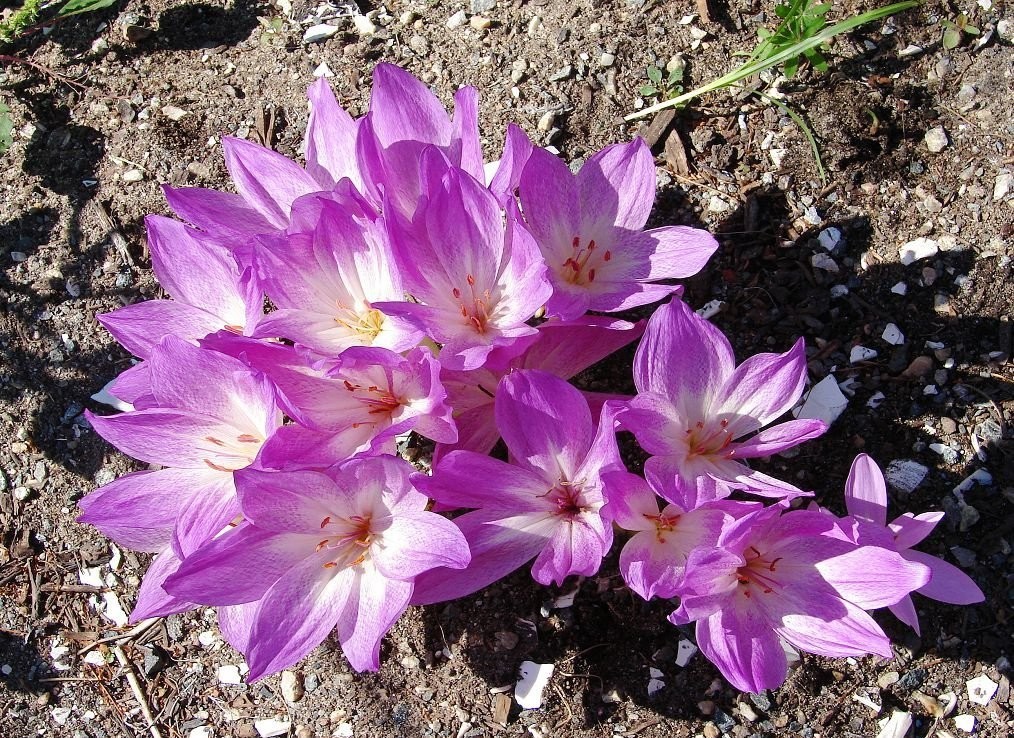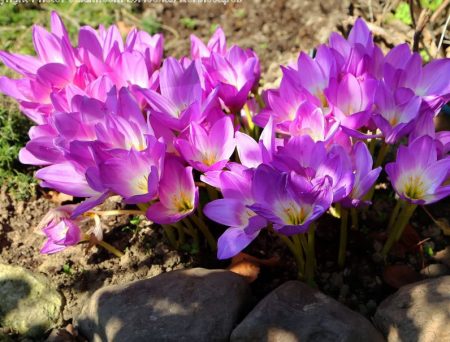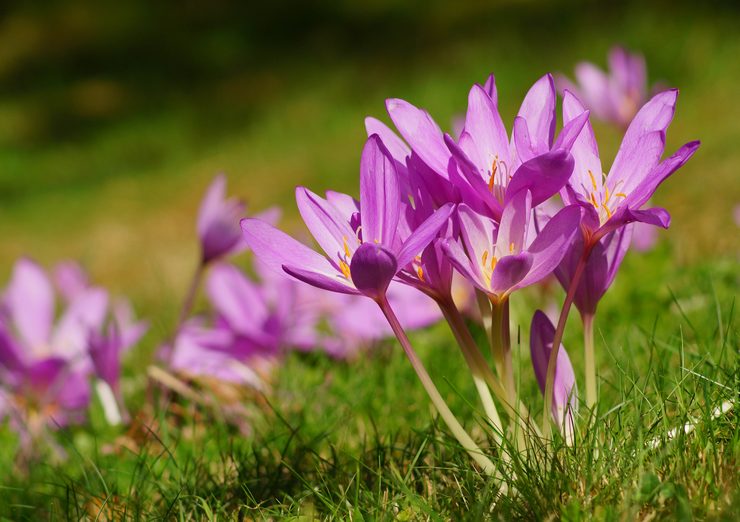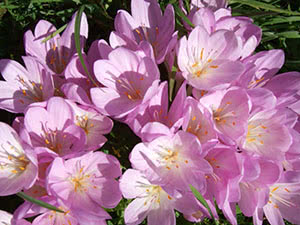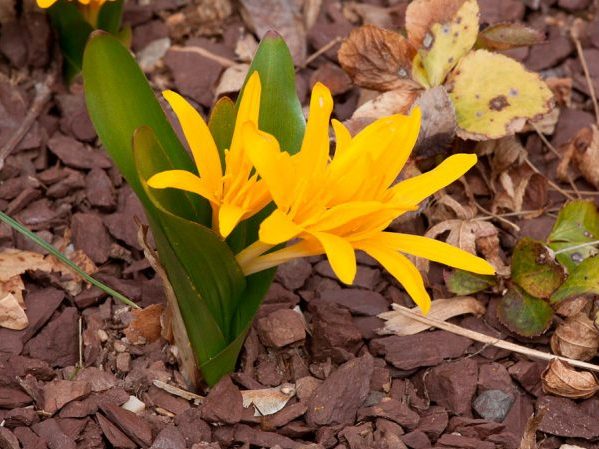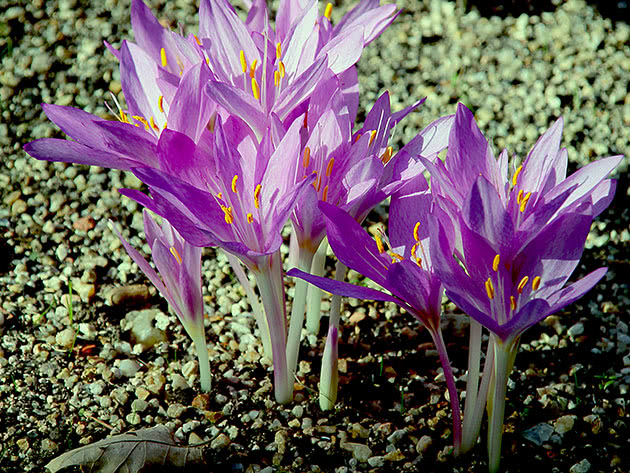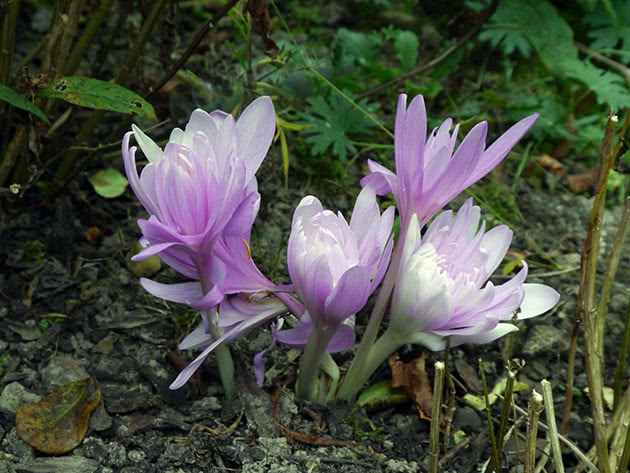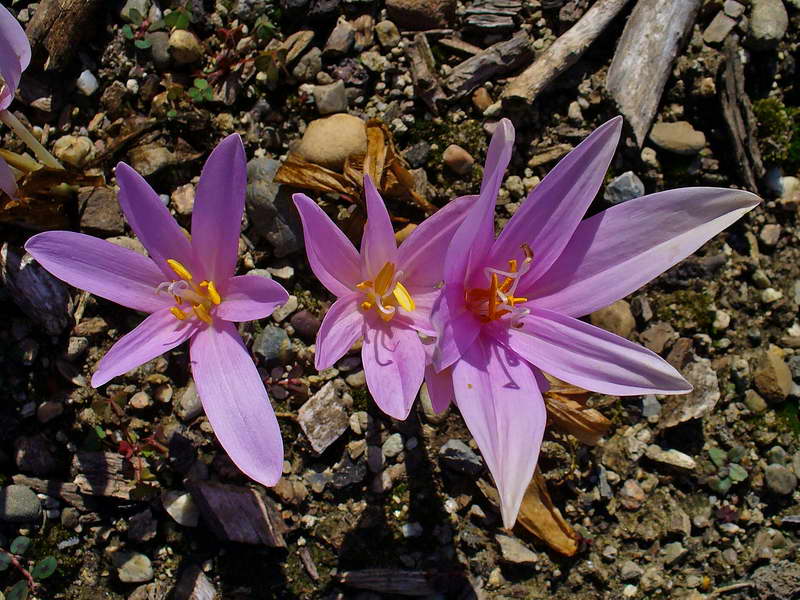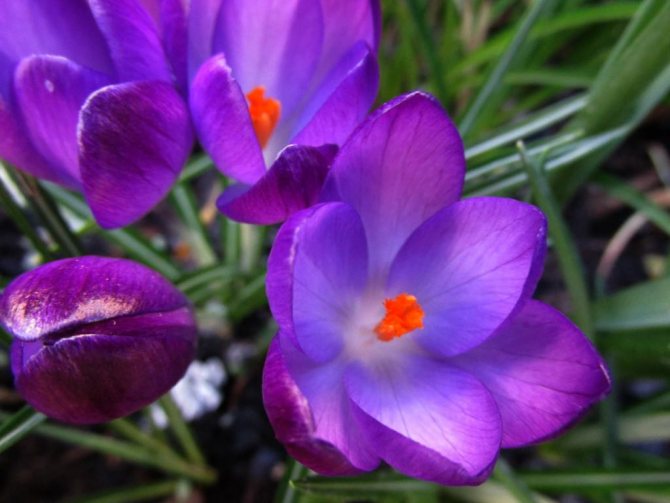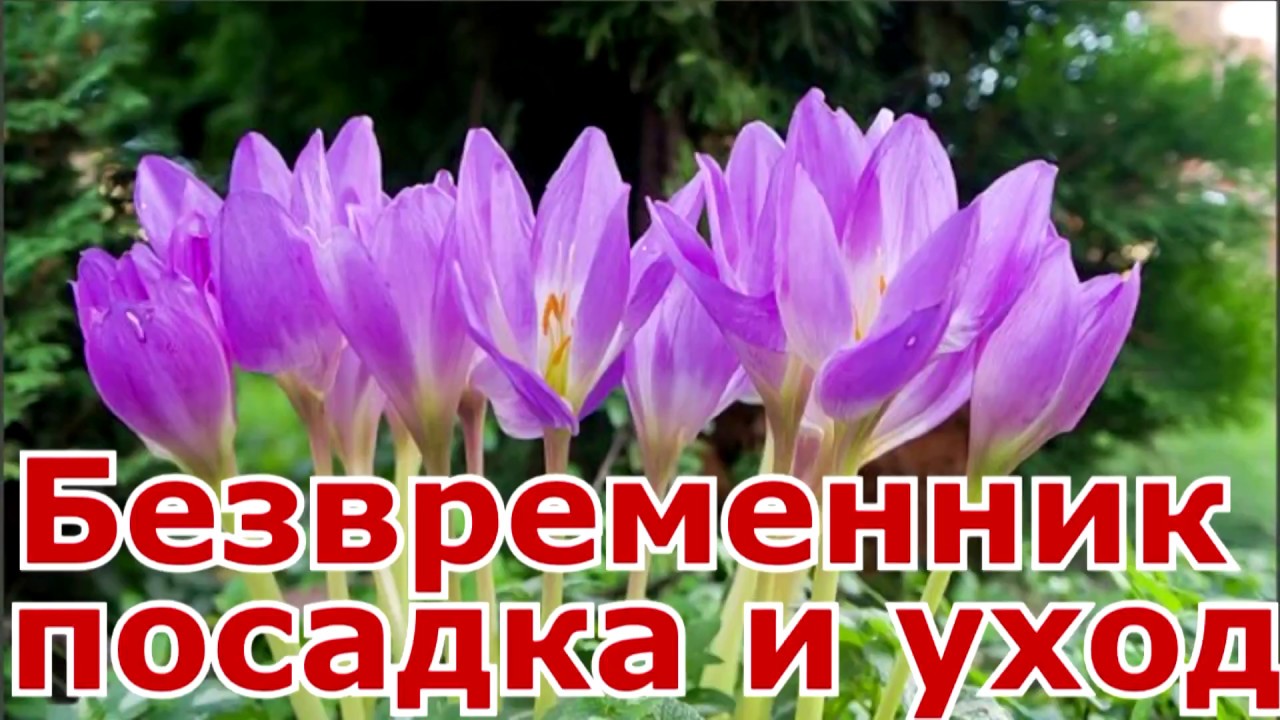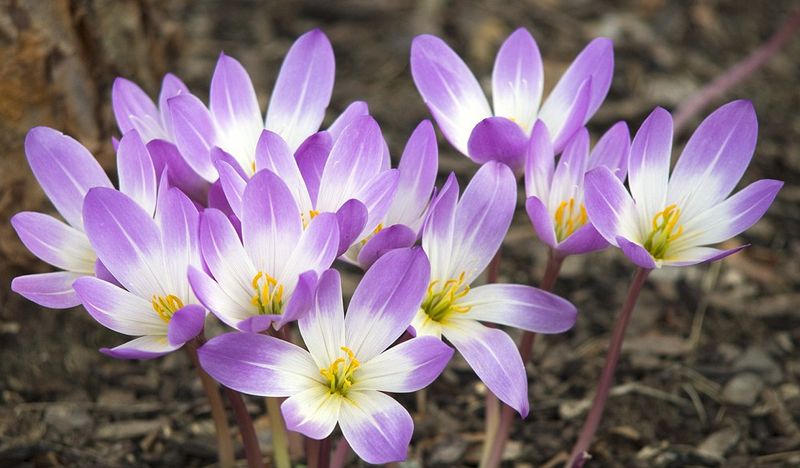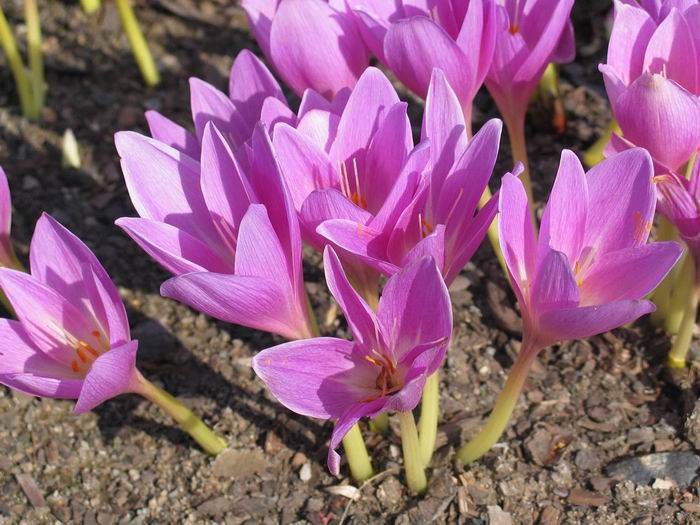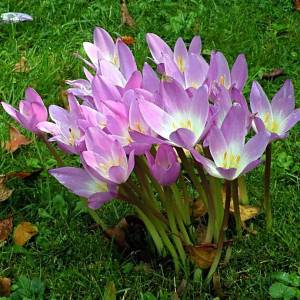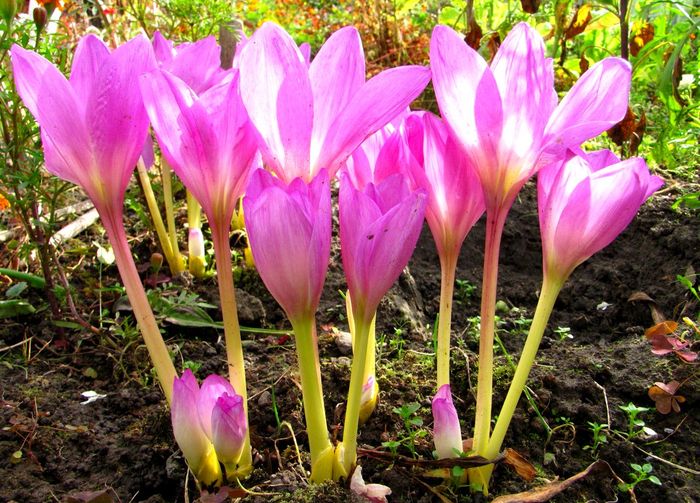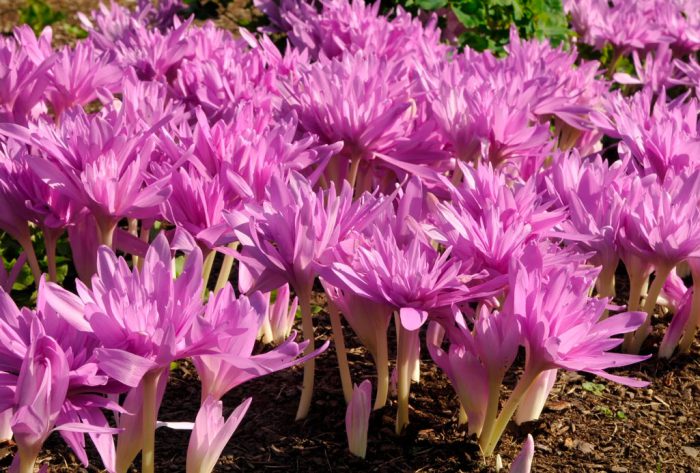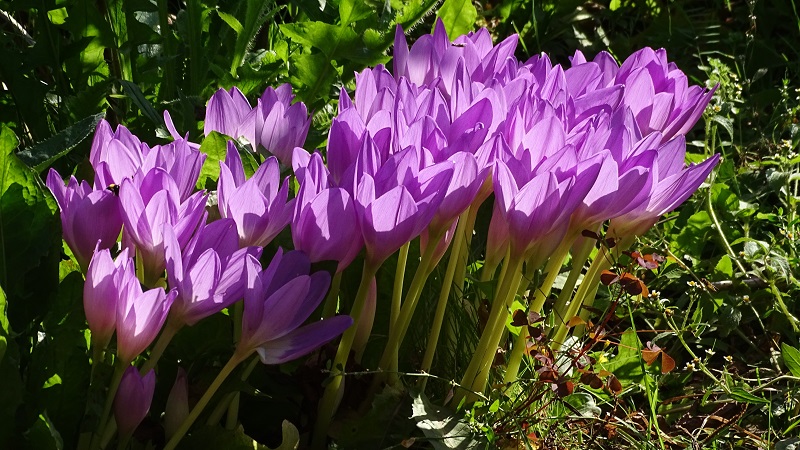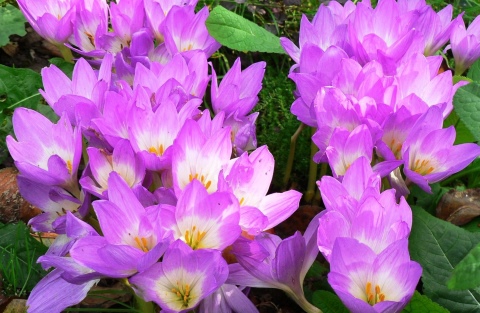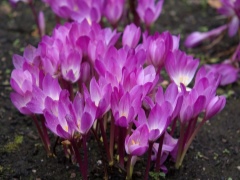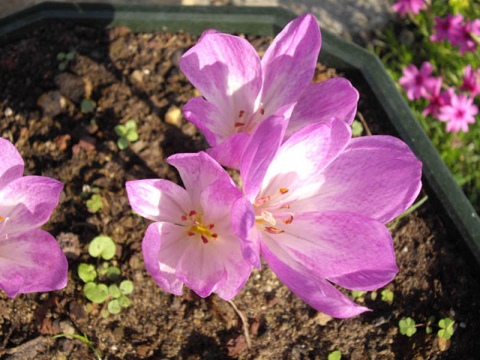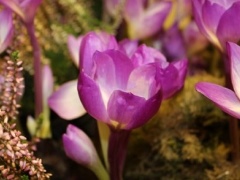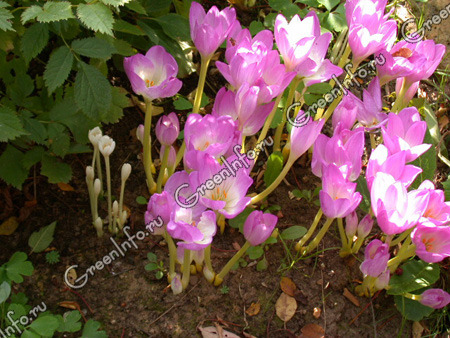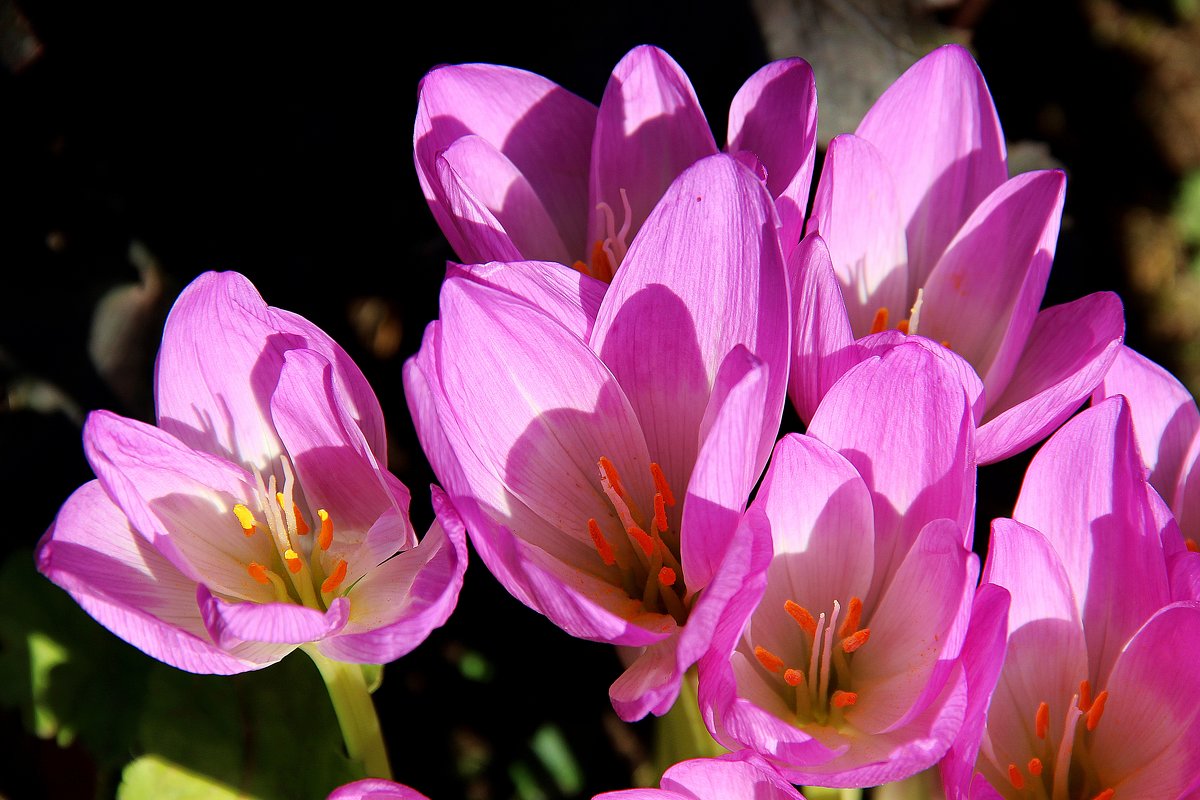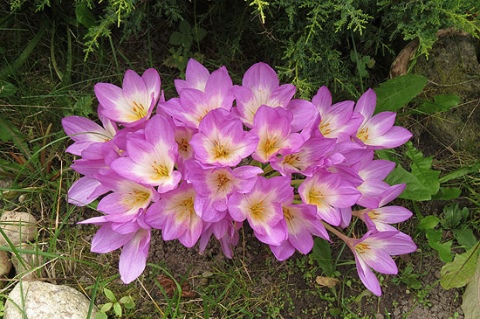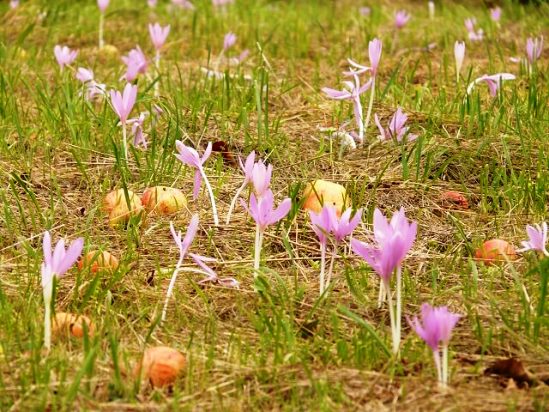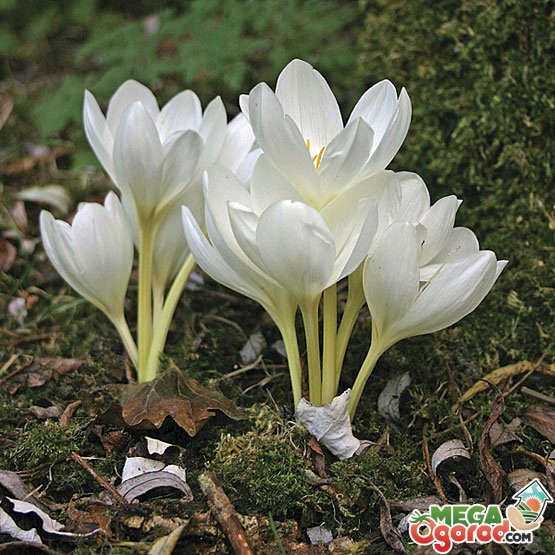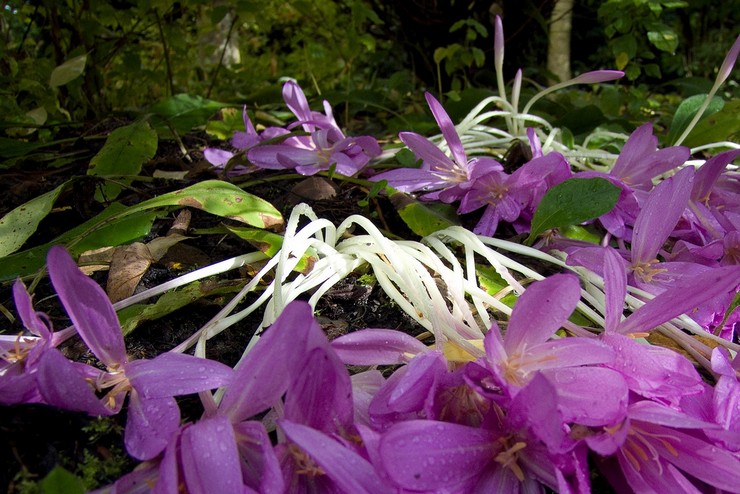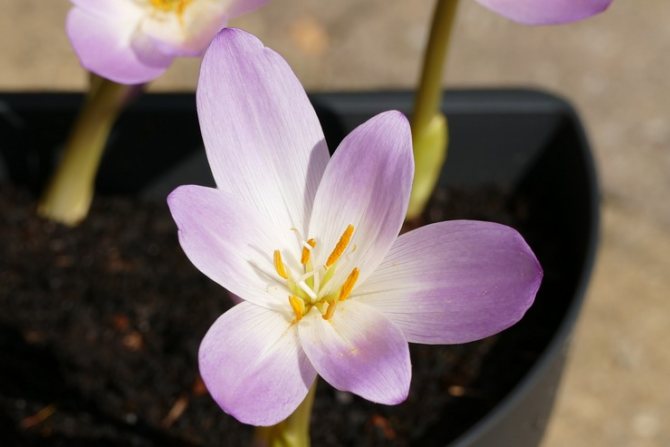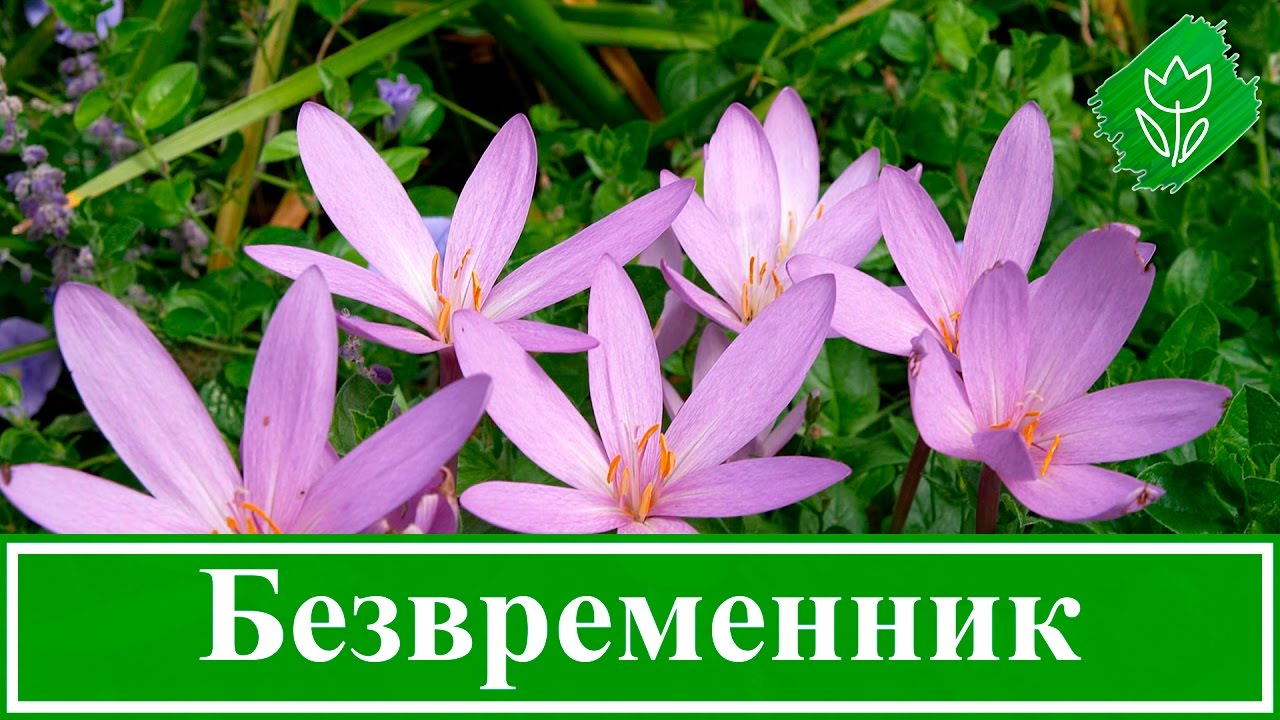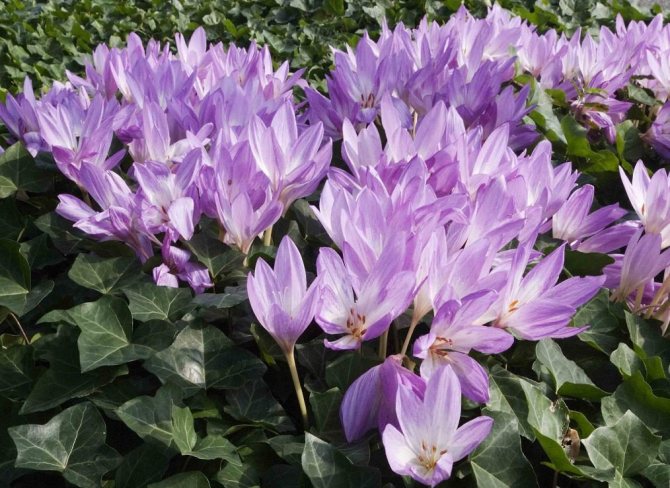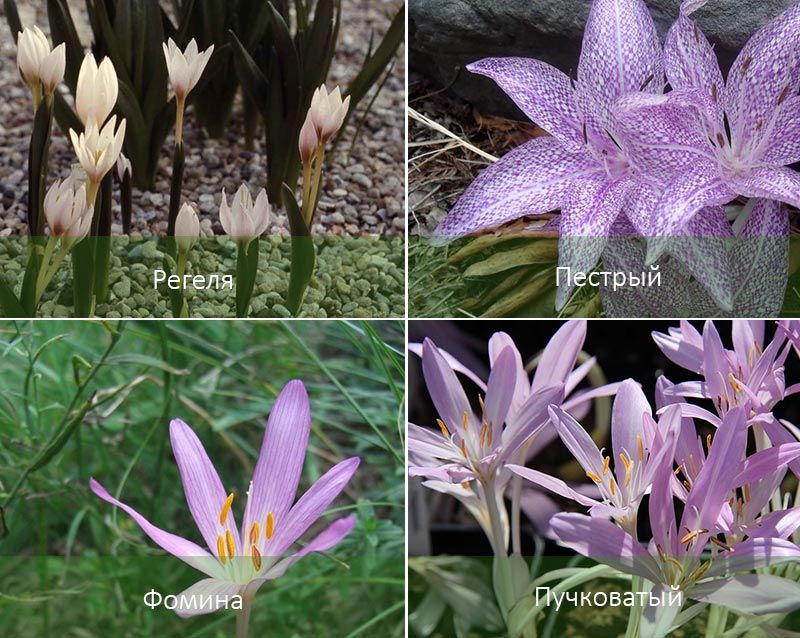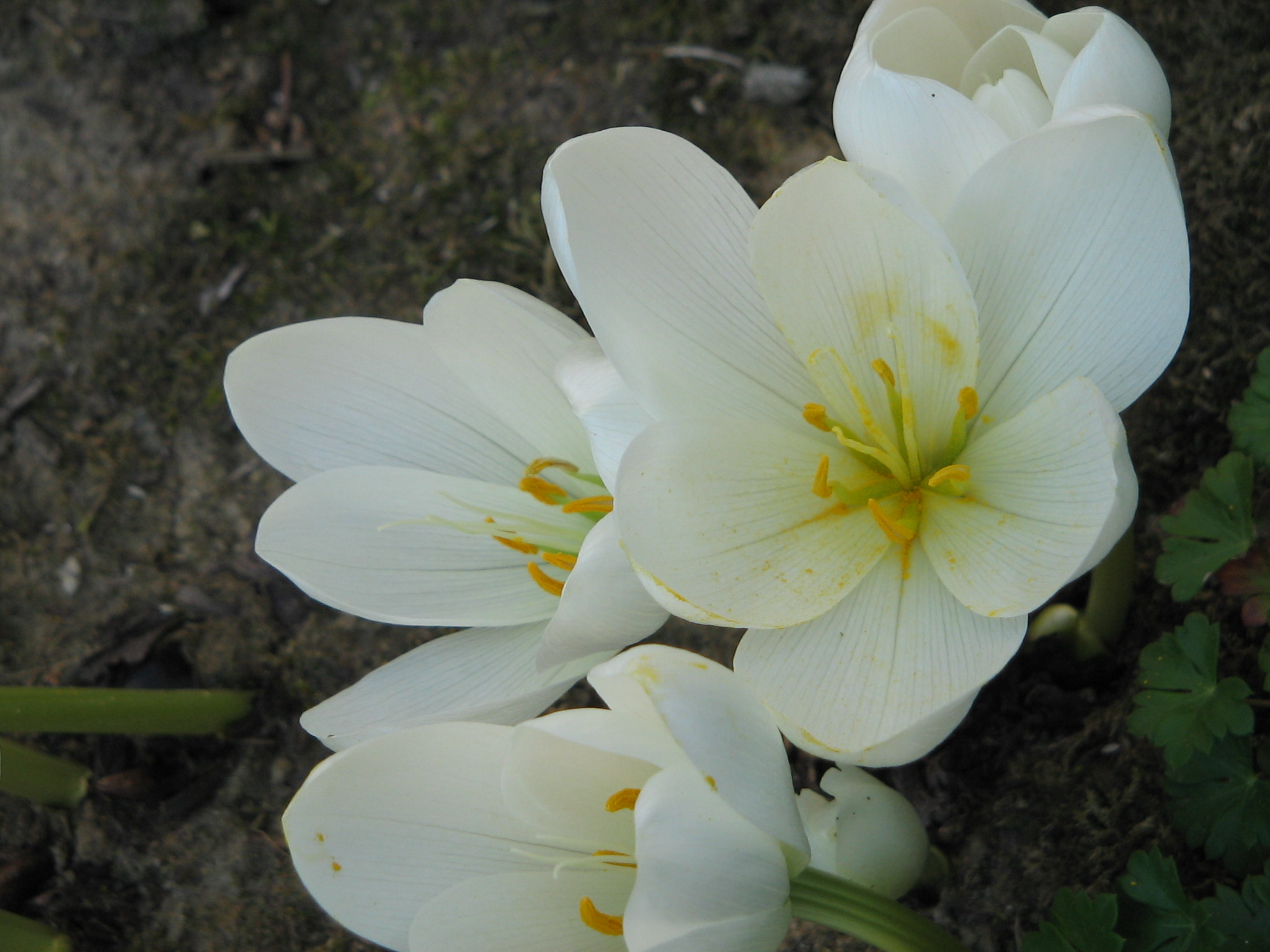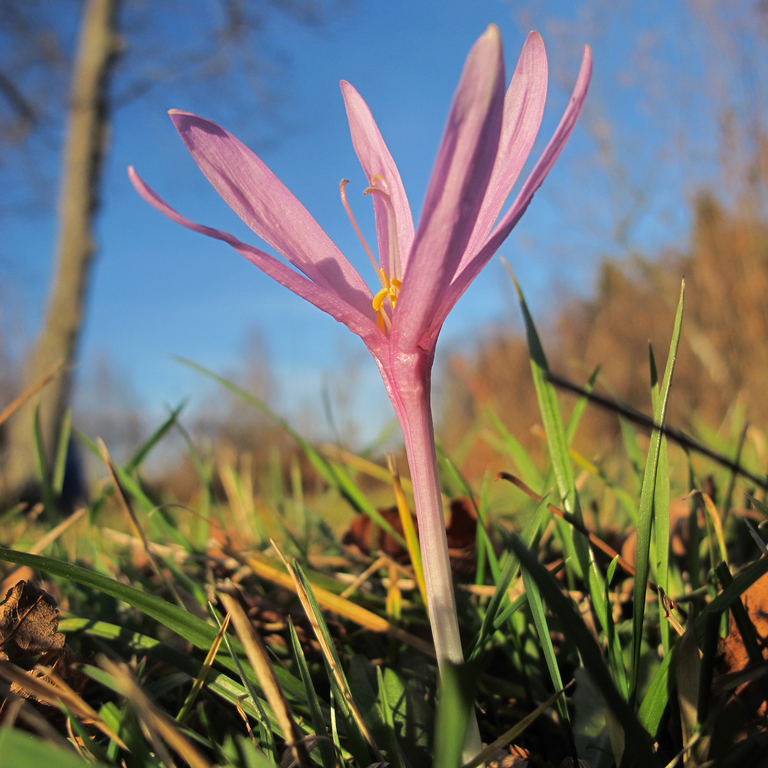Colchicum gorgeous: photo and description of the plant variety
A variety of this plant is the magnificent crocus flower, a description of which is presented below.

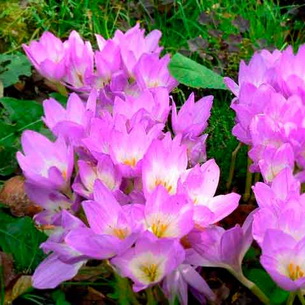
Colchicum magnificent (Colchicum speciosum stev., C. Liparochiadys woronow) is a herbaceous perennial with large oblong corms covered with dry dark brown leathery scales, which form a long tube at the top, covering the lower part of the shoot.
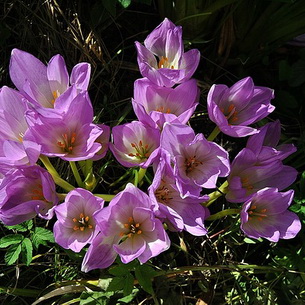
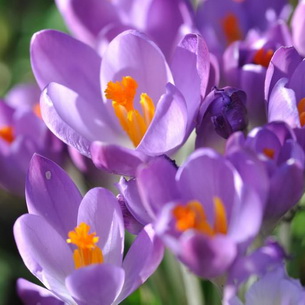
When describing the magnificent colchicum, it is worth noting its large beautiful flowers. They are pink-purple, lilac-pink, rarely almost white, odorless, bloom in autumn, 1-3 per plant. The perianth flexure in the pharynx is glandular, with six broadly oval (5-6 cm long and 1.5-2.2 cm wide), at the apex obtuse lobes; the perianth tube reaches 25-40 cm in length, its diameter is 0.3-0.6 cm.
Pay attention to the photo - the stamen of this type of crocus flower is almost half as long as the limb leaves, with linear yellow anthers 8-12 mm long:
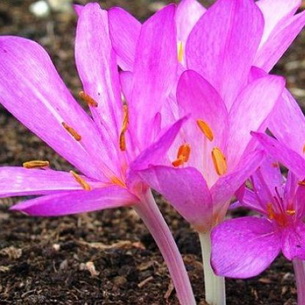
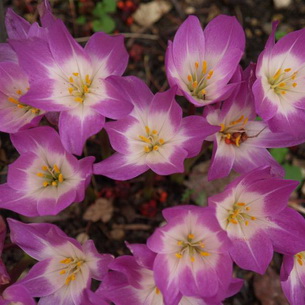
The column exceeds the stamens, it is thick, straight at the apex, with a truncated stigma.
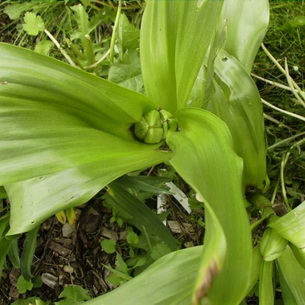

The fruit is a three-celled elliptical capsule 3-4 cm long. Seeds are round, brown, 2-3 mm in diameter. It blooms in late summer and autumn (depending on the height of the place of growth above sea level) - from the second half August before the start October. The flowering period of each population is 2-3 weeks.
As you can see in the photo, during the flowering period of the magnificent autumn crocus leaves are still undeveloped and hidden underground:
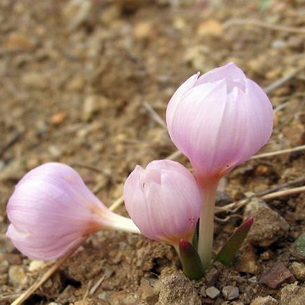

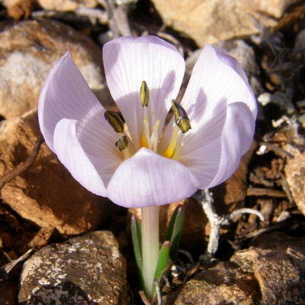
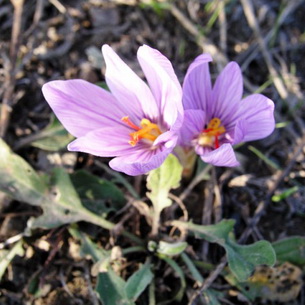
Leafy shoots and fruits appear on the soil surface next spring (in April - May). Seeds ripen in late May - June - early July. After seeding, the aerial part of the plant dies off. In summer (July - August), corms are in a state of growth dormancy. The change of corms occurs annually: maternal corms are replaced by daughter ones by the end of the spring growing season (May - June).
How to care for a cornfield outdoors
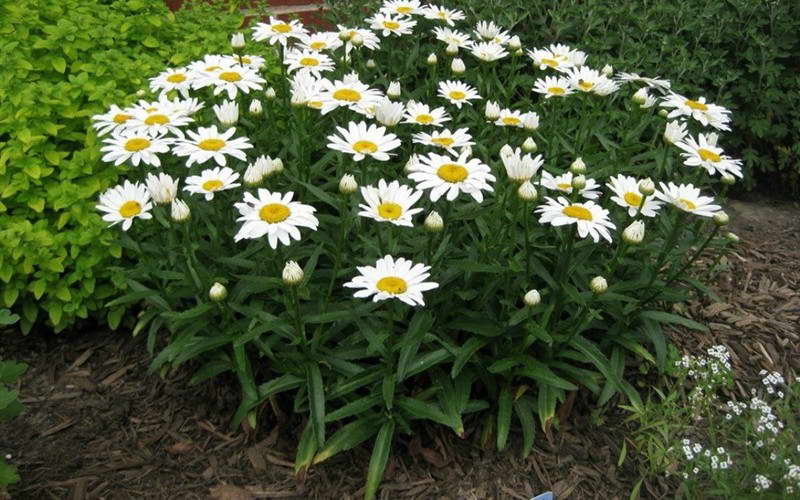
Nivyanik planting in open ground and care In the photo, the variety Snow Lady Snow Lady
Choosing a landing site
To make the flowering abundant, select a well-lit area for planting the plant, possibly slightly shading. From a lack of lighting, the stems will stretch, bend, there will be few flowers.
Priming
The soil is needed loose, fertile, light. Chernozems or loams of neutral and slightly acidic reaction are ideal. Too acidic soil is contraindicated. It grows poorly on clay and sandy soils. When planting for digging, add peat, compost, humus.
How to water
Water regularly, avoid stagnant water. In case of drought, add about 10 liters of water under each bush. To retain moisture, mulch the soil with sawdust, wood chips or pine needles.
Top dressing
Twice a month you can feed it by alternating mineral fertilizers with organic matter. You can apply complex mineral fertilizers, nitrophosphate, from organic matter, mullein infusion prefers. However, it is worth noting that the plant does just fine without any additional fertilizing in ordinary garden soil.
How to prolong flowering
If there is no need to harvest the seeds, cut the buds as they wilt - this will prevent the plant from losing strength and encourage re-flowering.
Preparing for winter
Prepare for wintering in autumn. When flowering is complete, shorten the stems, leaving about 10 cm of root foliage. In most cases, much effort is not required: the plant does not freeze out even in the absence of snow cover in winter. If in your area there are severe frosts of more than 20 ° C, it is better to cover a little daisy.Mulch with peat, additionally cover with fallen leaves, spruce branches. Remove the shelter in early spring.
About the main types and varieties
Almost all types of colchicum bloom in the fall. But, nevertheless, there are exceptions to the rules that bloom in spring and delight their owners. True, spring crocus is not widely popular.
About spring-flowering species
About yellow colchicum / Colchicum luteum /

it is known that it grows mainly in rocky places in the Himalayas, the Pamirs, the Tien Shan and Tibet mountains. I have been cultivating it since the end of the 19th century. The plant begins to bloom in early spring. The average diameter of flowers is 30 mm, in height it reaches 150 mm, the color is deep yellow. The flat leaves are deep green in color, they come to the surface at the same time as the flowers.
About Kolhikum Hungarian
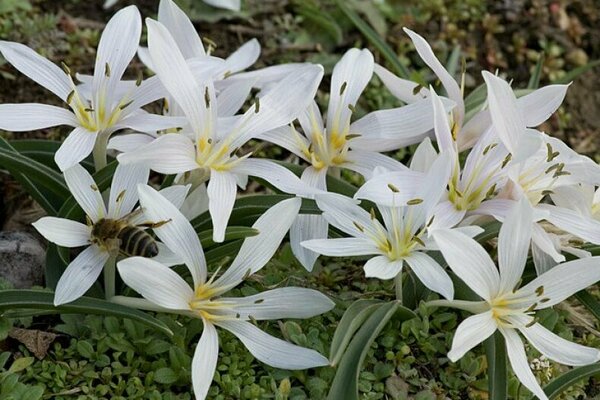
it is known that in addition to its homeland of Hungary, this species is also found in the territories of several countries - in Greece, Albania, Sebia, Slovenia, Macedonia, Croatia, etc. Flowers appear in February, as well as at the very beginning of spring. Pinkish-reddish or snow-white flowers with wine-colored anthers are a very beautiful sight
In addition, on the upper side and on the edge of the leaves there is a kind of thick fluffy cover, which also attracts attention. The most popular of this type is Velebit Star, which is often called the "star of the Croatian mountains"
About Ankara colchicum,
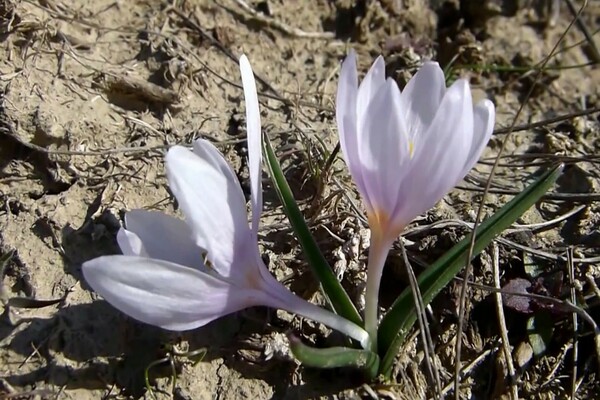
or three-leafed, or Bieberstein (early ephemeroid) it is known that it is found in countries such as Moldova, Ukraine, Crimea, Turkey. Each plant has three narrow and long gray leaves with cilia at the edge, and two to three or four mauve flowers.
It is known about the colchicum "Regel" ("Kesselring") that in nature it is found in the Alpine mountains above 2000 meters above sea level. In addition to the Alps, the places of growth are the Tien Shan and Pamir mountains. Its bulbs are elongated with leaves that have a smooth edge. Flowers are white, on one plant - up to 4 pieces, on the petals - purple stripes. It blooms in early spring as soon as the snow melts. The most popular colchicums of this type are water-loving, bunched and Shovich.
About autumn-flowering species
Colchicum in autumn, found in many European countries (in Latvia, England, Western France, etc.), has favorite growing places - above 2 thousand meters above sea level. The height of the bush is up to 0.4 m, the leaves are flat and oblong grow until the beginning of summer, and then wither. One bulb produces up to four lilac or snow-white flowers (up to 70 mm in diameter).
A little about the most popular types.
The autumn whites
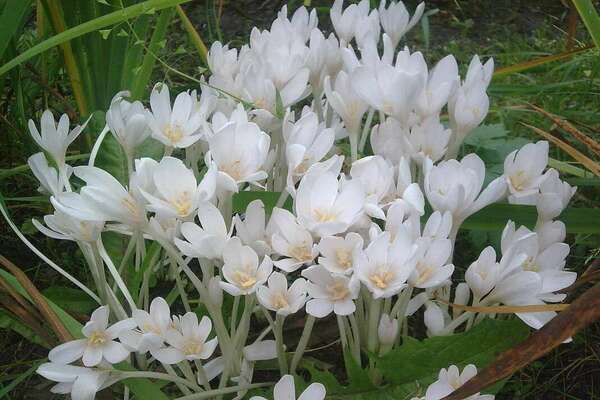
colchicum, quite rare in nature, flowers appear in September, one bulb gives 5-7 flowers up to 150 mm. The central part of the flower is yellowish with snow-white perianths.
Autumn terry
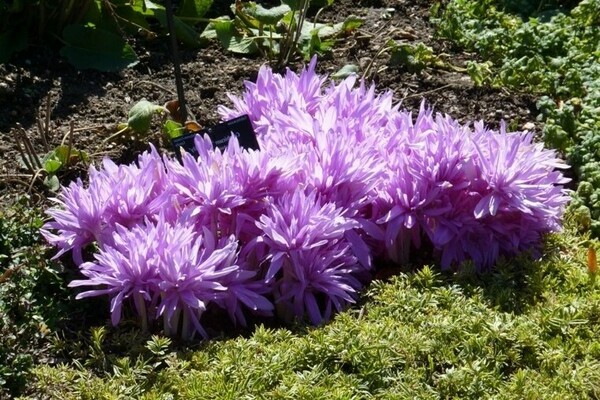
colchicums are the latest, they begin to bloom in the days of the last October decade. Flowers - purple, up to 120 mm high, with a flower diameter up to 5 mm. One flower has up to 35 petals. The leaves can be up to 25о mm long, up to 50 mm wide, dark green in color.
Autumn white terry colchicum hides about 45 petals on each white flower. The time for flowers to appear is mid-September.
The neddiste, which is bred in the Czech Republic, has pale pink flowers.
There are species with petals of different shades of purple. Purplish pink petals with white center like Baconsfield.

Now - about the magnificent colchicum,
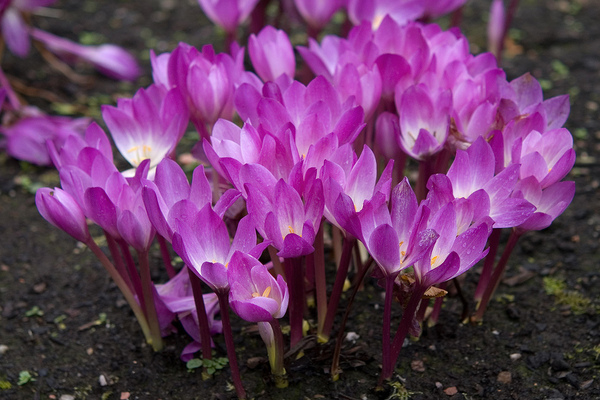
found on the Turkish, Caucasian land, in the north of Iran, the growth is larger in comparison with other species and reaches up to 0.5 meters. Dense green leaves are also larger - up to 300 mm at width 60 mm. The leaves have wavy edges, they begin to dry out by summer. The flowers are large, lilac or mauve with a whitish tube. Blooms in September.
This species is famous for many different forms: colchicums are burgundy, whitish, huge, etc.
Popular varieties: Huxley (with many mauve flowers that turn purple over time), Waterlily (this colchicum has double purple flowers), Premier (this late blooming colchicum has bright purple-pink flowers).
There are a lot of autumn-blooming colchicums, flowers - of various shades, leaves - of different shapes and sizes. Kolhikums are now very popular among gardeners, both beginners and professionals.
Colchicum
Colchicum: features
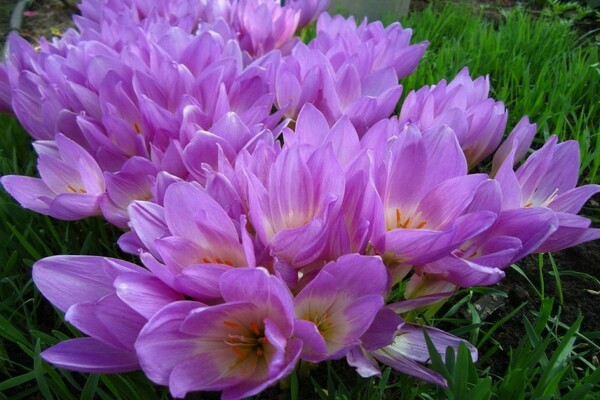
Colchicum
The perennial herbaceous crocus is an ephemeroid. Its numerous short shoots have a small number of large lanceolate-elongated plates. The leaves of the crocus, lengthening and developing in the spring, stop growing by June, fall off, and the plant becomes leafless.
Colchicum root tubers are covered with a brown shell. A long tube (perianth) is formed from it, covering the flower below.
Colchicum blooms mainly in spring. Funnel-shaped flowers, similar to crocuses, emerge from the ground. The length of the colchicum reaches up to twenty centimeters, including the perianth.
Interestingly, this plant is completely poisonous, which became known in the days of Dioscorides. Moreover, all parts of this seemingly harmless plant are saturated with poison. Even fruits, which are spherical three-nested capsules.
Beneficial features
Despite the fact that the plant is from a number of poisonous, it is actively used in folk medicine. Colchicum has the following effect on the human body:
- The substance colchicine is the basis of medicines for gout and inflammation of the walls of the blood veins (phlebitis).
- Medicines from colchicum are used in violation of protein metabolism and joint diseases.
- Colchicine is used to create tablets for use in dentistry.
- The second most valuable substance produced from colchicum is kolchamin. Medicines with it in the composition are used to treat cancer.
- Colchicum herb has a diuretic effect.
- Decoctions and infusions have long been used for rubbing with rheumatism, osteochondrosis and other diseases of the musculoskeletal system.
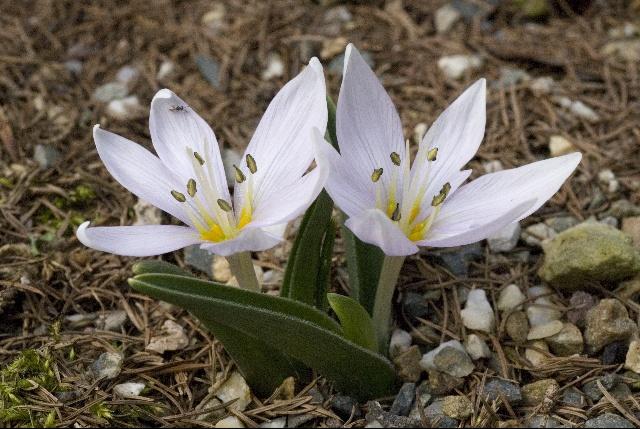
Even having an idea of colchicum poisoning, they use it with caution to induce vomiting, and as a laxative medicine.
How to propagate?
There are 2 ways of reproduction of the magnificent colchicum: seed and root. Let's consider both.
Seminal
It is rarely used, since the plant obtained from the seed will bloom only after 5-8 years. In addition, this method is not suitable for all varieties. If you decide to experiment, then here are its stages.
- Collect seed in June. Don't store it, try to drop it as soon as possible.
- Prepare the soil: it should be loose and fertile. Avoid waterlogging.
- Cover the bottom of the planting tank with small pebbles or sand as a drainage layer.
- Soak the seed in water for a while, then sow it into the ground, not too deep.
- Water the plantings from time to time.
Seeds can be stored for no more than 5 days and only in the cold. The first shoots will appear in the spring. As it gets warmer, you can move them to the site.
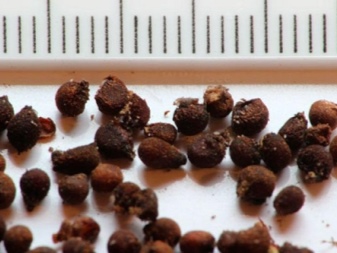
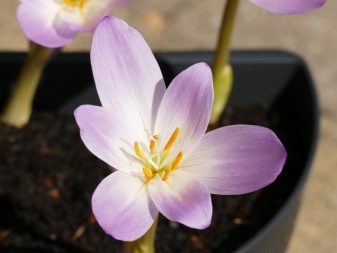
Root
Most often used. The stages of reproduction are as follows.
Collect mature bulbs in mid-July
Proceed with caution.
Carefully remove the remaining soil from the onions without touching the scales.
Soak them in a weak potassium permanganate solution for 30 minutes.
Remove the bulbs to dry.
Place them in a dark and cool room (cellar) before disembarking.
Onions are planted on the plot in August. Pre-loosen and fertilize the soil.
The planting depth is 12 cm, the interval between specimens is 20 cm.
It is recommended to transplant the crocus every 3 or 4 years with the destruction of old corms.


In the next video, you will find the features of growing crocus.
Crocus reproduction
Column can be propagated both by daughter bulbs and by seeds. But the second method will take much longer. For a seed-grown bulb to gain strength and bloom, it will take 6-7 years.
Cultivation of crocus from seeds
This type of propagation is suitable for plants of those species that do not form daughter bulbs (for example, yellow crocus). Seeds are sown immediately after they ripen and are harvested in June, after soaking them in water. The soil for sowing should be fertile, moist and loose, preferably with a drainage layer.
The seeds are placed in the ground at a shallow depth. Seedlings will appear only next spring. Sometimes they need more time to germinate. Further care for young plants is simple: thinning, weeding, watering as needed and shelter for the winter.
Cultivation of crocus from daughter bulbs
Colchicum can grow in one place for 6-7 years, but due to the overgrowth of bulbs, it is recommended to replant it every 2-3 years. August is the most suitable time for planting and transplanting a flower.
The bulb during this period is dormant and has a good supply of nutrients.
It is carefully dug up, dry leaves are removed and cleaned of soil. Then the bulbs are washed in water and disinfected with a pink solution of potassium permanganate
Before planting, they are dried in a dry, semi-dark place and stored at a temperature of about 24 ° C.
Although the plant is undemanding to the soil, it develops better in loose and fertile soil. However, it can adapt to other types of soil and its different acidity. But the crocus does not like excess moisture, therefore, when planting it, flooded, swampy places should be avoided. The flower grows equally well in sunny areas and with slight darkening.
Colchicum is not recommended to be planted in the shade of tree crowns, where, due to dampness, there are many slugs that can eat it.
Before planting, the soil should be dug up and fertilized with mullein and superphosphate. If the soil is heavy, it must be mixed with rotted sawdust and peat.
Depending on the size, the bulbs are planted to a depth of 8-12 cm (small and medium) or 20-25 cm (large), at a distance of 20 cm from each other. Scaly tube bulbs should look out of the ground: a bud will pass along it to the surface.
It is good if peonies or junipers grow next to the crocus, which will distract attention from its withered foliage in the summer. The crocus bulbs planted in August will bloom in about a month and a half
The crocus bulbs planted in August will bloom in about a month and a half.
Care
Colchicum is loved by gardeners for its ease and low demands.
When caring for an autumn tree, special attention should be paid to spring feeding and replanting bulbs. How does this happen?
How to transplant to another location
In one place, crocus is allowed to grow for 6-7 years. Further, he requires a transplant. Usually, in the fall, a lot of leaves concentrated in a bunch appear, which means that daughter bulbs have grown on the uterine bulbs. Such colchicums will stop blooming in the fall and begin to hurt. It is necessary to start digging the bulbs in late spring, early summer, when the greens are completely dry. You need to transplant to a new place in August. During this period of time, the bulbs are thoroughly washed, processed with potassium permanganate, and dried. In this form, they are stored in a cool dark place until August.
Diseases and pests
Snails and slugs are frequent guests on croplands. They are attracted by the lush green foliage, especially since the plant usually grows in the shade of other shrubs or tall flowers.Any insecticide is used to control pests. To prevent the snails from attacking the autumn people, eggshells are laid out on the flowerbed, small pebbles are scattered. With abundant humidity, the leaves become covered with gray rot. Fungicides for any flowering plants help here: Topaz, Champion. Severely damaged shoots should also be removed, and the soil should be allowed to dry before the next watering.
Top dressing and watering
Feeding colchicum should be started in the spring, when leaves appear from under the ground. Nitrogen fertilizers are applied to the surrounding area. This will allow the plant to have very large leaves, which will store enough nutrients in the bulb for further flowering. In the fall, any organic fertilizers or mineral complexes for flowering plants are introduced for digging.
When buds begin to hatch from under the ground, and the trees have not yet acquired foliage, the colchicum has enough illumination, then, before the greenery dies away, light is also not needed. During flowering, the foliage on the trees is gone, so the peduncles are bathed in an abundance of light. And you do not need to water, since the colchicum is preparing for a dormant period. In general, it is easy to care for the plant in this regard.
Diseases and pests
The main pests of the crocus are snails and slugs. As a prophylaxis against these pests, flower growers are advised to lay out paths of eggshells, broken shells, small stones between the rows of plants. Around the perimeter or circumference of a flower bed or flower garden, you can place plastic gutters (made of plastic bottles or the remains of plastic pipes) with water, which will become a reliable barrier for uninvited guests eating the leaves.
A possible disease is gray rot. It can appear from excess moisture in the soil and constant excess watering. This fungal disease can completely destroy the entire flower garden, if rescue measures are not taken in time. At the initial stage, it is recommended to urgently treat flower crops with special preparations (for example, Topaz, Champion, Kuproksat), stop watering and destroy completely diseased plants. In the future, it is necessary to strictly observe the requirements for watering and not forget about preventive measures.
Application
Due to the content of alkaloids in seeds and bulbs, all crocus crops are poisonous plants. They are dangerous for livestock grazing in pastures and for people if you work with the plant with your bare hands. A dangerous for humans dose of the alkaloid colchicine is 0.02 g (6 g of plant seeds). At the same time, parts of the plant (seeds, flowers and tubers) are used for medicinal purposes. Colchicum is not used in everyday life and cosmetology.
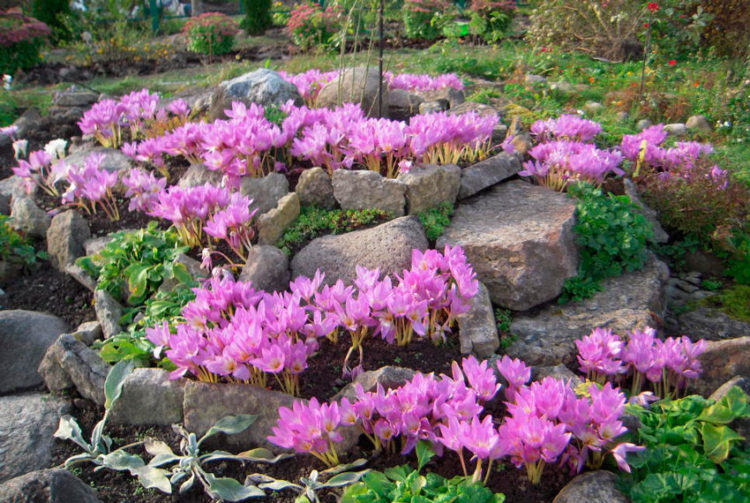
Seeds and bulbs are used in the manufacture of medicines for nephritis, in the treatment of leukemia, gout, sciatica, arthritis. In folk medicine, it is advised to drink a tincture of tubers to obtain a laxative, diuretic and analgesic effect. An anesthetic ointment is prepared from the flowers. It is rubbed with radiculitis, rheumatism, gout, arthritis.
A plant-based ointment is used to treat skin cancers, since colchicine inhibits cell division. Pharmacists believe colchicine also inhibits the growth of tumor cells.
What does the crocus look like and where does the flower grow
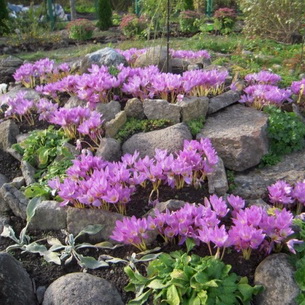

Corm perennial in a vegetative state up to 30 cm high. The corm is conical, covered with dark brown, membranous scales.

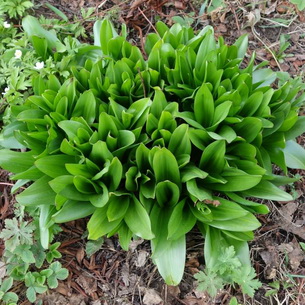
The leaves are large, up to 30 cm long and 6 cm wide, bright green, with a slightly wavy edge, dying off by early summer. Many people note that the crocus looks like a crocus: its flowers are very large - up to 7 cm long - with a long white tube and lilac or lilac-pink corolla lobes. One corm forms up to 4 flowers. Blooms in September-October. The seeds ripen in late May-June. After seeding, the aerial part of the plant dies off.It has many garden forms and varieties, differing in the color of the flower (white, dark red, red, etc.), the shape of the flower and the degree of its doubleness.
See how the crocus flower looks like in these photos:

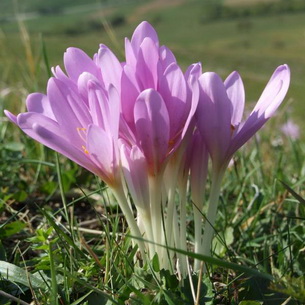
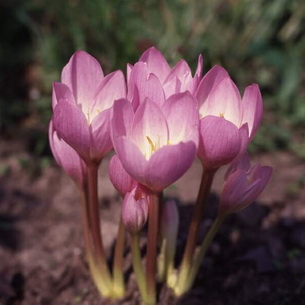
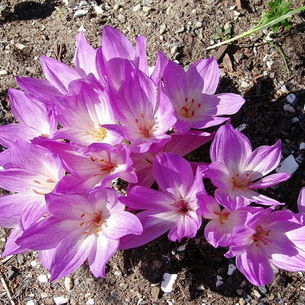
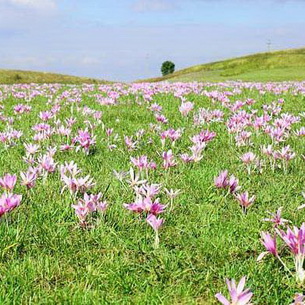
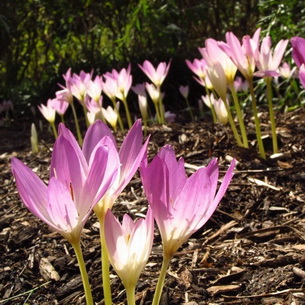
Here this species grows in beech, beech-chestnut and beech-hornbeam-maple forests, riverside alder forests, in shrub thickets, in forest clearings and edges in the belt of fir and spruce forests. It can grow strongly in various associations of secondary mid-mountain meadows.
When describing the crocus, it is worth noting that massive thickets are characteristic of the following formations of the subalpine belt: park maple woodlands, tall grasses and subalpine meadows. Mid-mountain and high-mountain populations of colchicum (colchicum) in the western part of its range are usually spatially separated by a belt of dark coniferous fir forests, under the canopy of which this species does not occur. In the central and eastern parts of the range (in the Greater Caucasus and Talysh), the distribution of the crocus is limited to the upper forest and subalpine belts within an altitude of 1200 - 3300 m. and also in groupings of depleted tall grasses, bracken thickets and in parks of oriental oak.
As you can see in the photo, the crocus plant in forest glades, edges and under the canopy of beech forests is found scattered, not forming thickets anywhere:
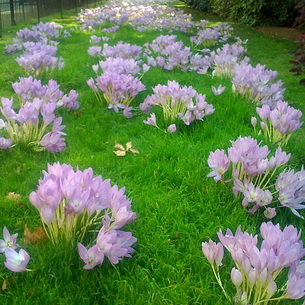

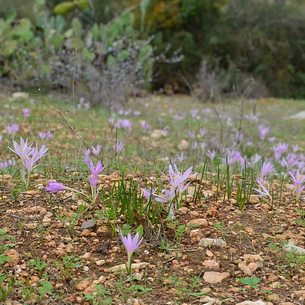
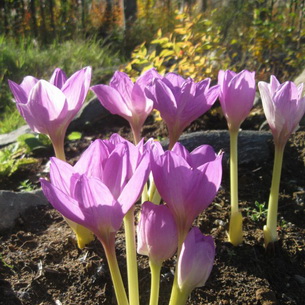
In the eastern part of the range, forest and subalpine populations of colchicum often come into contact with each other. Throughout the entire area of the range and at all altitude steps, there is a clearly pronounced focus in the distribution of the crocus. It can be abundantly represented in various ecological and phytocenotic conditions of some mountain tracts, but completely absent in similar conditions in other closely located points.
Look at the photo of the crocus, the description of which is given on this page:
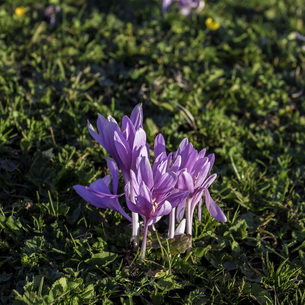

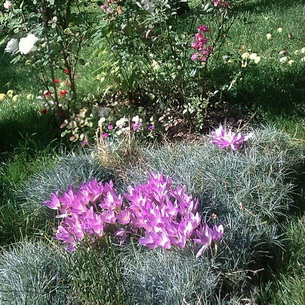
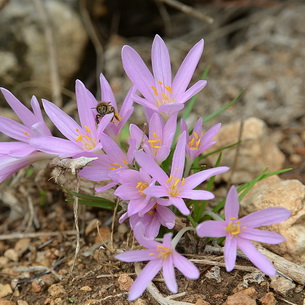
Getting to know the crocus flowers that bloom in autumn
Blooming in late autumn is a distinctive feature of most croplands. Despite the fact that among the 70 species of this plant there are also crops that bloom in spring along with primroses, autumn crocuses have earned universal love and popularity. With the beginning of spring, only leaves wake up in them, then a period of complete rest begins, and in the fall the main "show" begins - when the garden is almost constrained by the breath of cold, surprisingly delicate flowers flash with touching stars.
The foliage of the colchicum is large, classic lanceolate, long and characteristic of bulbous. It dies off at the beginning of summer, and until autumn the plants show no signs of life. When the beauty of autumn crowns can be fully appreciated in the garden, and the chores of harvesting the leaves will take most of the time, single funnel-shaped flowers rise from the ground as if by magic.
At the same time, some species of colchicum wake up literally before the snow falls, when it is already very cold in the garden. Growing up to 20 cm in height, they also surprise with the fact that the perianth in the form of a narrow tube-stem is more than half hidden in the soil. After flowering, crock-crops manage to set three-nested boxes with seeds hidden in the ground, which will appear only together with leaves in spring.
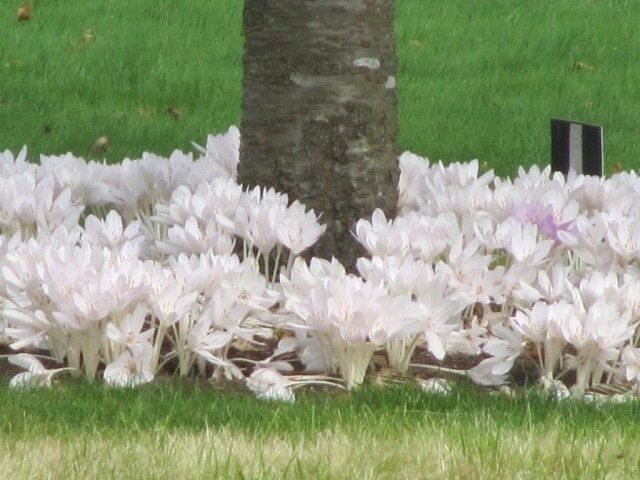 Colchicum, or Autumnal, or Colchicum. Leonora enking
Colchicum, or Autumnal, or Colchicum. Leonora enking
Planting hyacinths in the ground before winter
Soil for hyacinths
The area for hyacinths should be protected from the wind, well lit, but these flowers do not tolerate excess sunlight. Hyacinths are often planted near shrubs or trees, although this is far from the best place for flowers, since the roots of large plants absorb almost all nutrients from the soil. Hyacinths grow best in neutral drained soil with a pH of at least 6.5, consisting of turf, leafy soil and sand.It is advisable to lime the acidic soil, and add sand to the clay soil, and this must be done in advance.
Before planting hyacinth, the soil on the site is dug up to a depth of 40 cm with wood ash or dolomite flour in the amount of 200 g per m², superphosphate in the amount of 60-80 g per m² and humus or rotted manure in the amount of 15 kg per m² of the site ... Hyacinths will not need nitrogen fertilizers either in autumn or in winter. The soil is prepared for planting in late July or early August.

How deep to plant hyacinths
Large hyacinth bulbs with a diameter of about 5 cm are immersed in the soil by 15-18 cm, and standard-sized bulbs - to a depth of 12-15 cm.In fact, the depth is calculated according to the same scheme as when planting lilies, tulips or daffodils in the fall: an earthen layer above the bulb should be 2 of its length, and the depth of the hole should be three lengths. But since when planting, it is necessary to take into account not only the size of the bulbs, but also the composition of the soil, it should be borne in mind that on light soils, holes are made 2 cm deeper, and on heavy soils - 2 cm shallower.
The feeding area of standard bulbs is 15-20 cm, it is at this distance from each other that hyacinths should be planted. Small planting material is placed denser. By the way, the largest, so-called collapsible bulbs, are best used for forcing, and hyacinths are grown in the garden from medium-sized bulbs - they are more resistant to weather disasters and diseases.
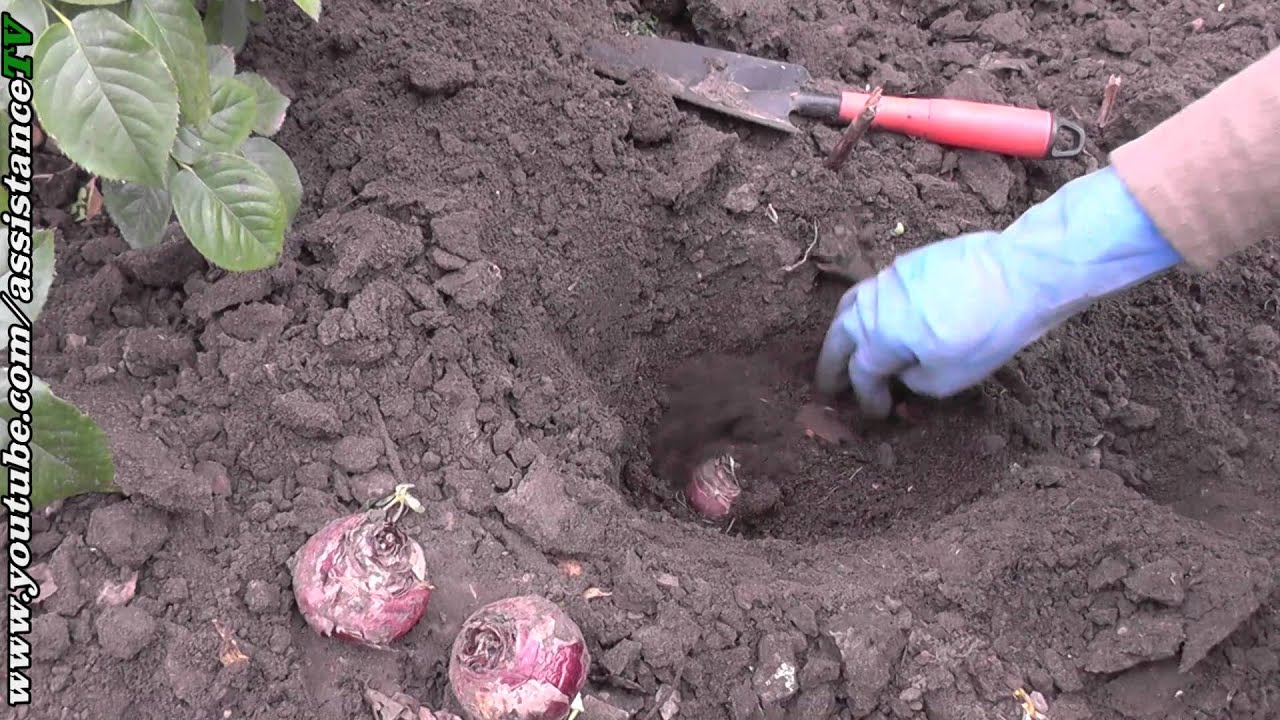
Before planting, the bulbs are placed in a fungicide solution or in a dark pink solution of potassium permanganate for half an hour.
How to plant hyacinths in the fall
Dig holes of the required depth at the required distance and, if you did not bring humus or rotted manure into the soil during digging, throw a handful of fertilizer directly into the holes, then pour a layer of coarse sand 3-5 cm thick into each hole for drainage, lightly press into it is the bottom of the onion, cover the onion completely with sand and finish filling the hole with soil. If you have planted hyacinths in dry soil, be sure to water the area after planting.


